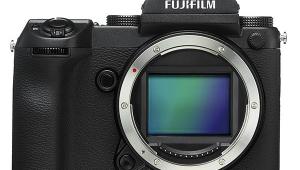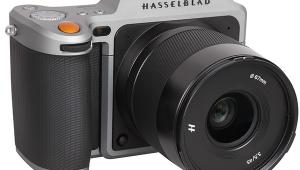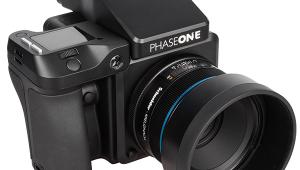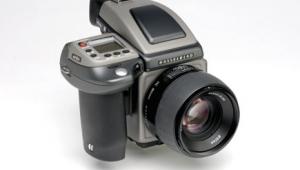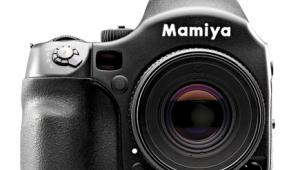Go Big: We Pick Our Favorite New Medium Format Cameras And Lenses

Some photo assignments require you to bring out the big guns. And when it comes to digital photography, there are few bigger guns than medium format systems. More digital SLR users have been making the jump to medium format now that several new models are equipped with CMOS sensors that can capture relatively low-noise images at high ISOs, shoot photos more quickly, and capture HD and even 4K video. Combine these handy features with the massive amount of resolution and extremely high image quality you get from the huge imaging chips in medium format camera systems, and there’s no better time to go big. Here’s a look at the latest cameras and lenses from five major medium format brands.
Leica
One of the biggest appeals about Leica’s S-series medium format cameras is they don’t look like medium format cameras. In fact, Leica’s S models are gorgeous—which is not a put-down of the many fine-looking competing cameras out there—and they feel wonderful in your hand. The latest Leica S is the Type 007 model—a seemingly coincidental James Bond reference—and while it looks and feels similar to the previous version, it’s got a host of new features. The Leica S (Type 007) is equipped with a new 37.5-megapixel (30x45mm) Leica CMOS sensor, which is the same resolution and size as the CCD chip in the previous model but it should have better low-noise, high ISO shooting capabilities thanks to the benefits of CMOS. We haven’t tested the Leica S (Type 007) yet but its ISO range has increased to a maximum of ISO 6400. (The previous model capped out at ISO 1600.) There’s also a new Maestro II image processor, which, combined with the CMOS sensor, enables the Leica S (Type 007) to achieve a class-leading burst rate of 3.5 frames per second. The Leica S (Type 007) can shoot Full HD video in full-frame medium format sensor size, along with 4K video (another first for medium format). It has a Live View mode and offers 2GB of buffer memory for sustained burst shooting. Even with the faster 3.5 fps burst rate and bigger buffer depth, the new focal plane shutter in the revamped Leica S is rated to last at least 150,000 cycles.
On back, the Leica S (Type 007) has a three-inch LCD screen with 921,600 pixels. It includes integrated GPS for location tagging of images and there’s built-in wireless, allowing the new Leica S to work with tablet computers, smartphones, or desktop computers without cords or cables. The Leica S (Type 007) will go on sale in March 2015 for $24,500.
Phase One
Phase One hasn’t had any major medium format news since introducing the well-reviewed (and very expensive) IQ250 in early 2014. That was the first digital back to use Sony’s excellent 50-megapixel CMOS sensor, a refreshingly low-noise chip that has since turned up in medium format systems from Hasselblad and Pentax. Building on the success of the IQ250, Phase One added the Schneider Kreuznach 40-80mm f/4.0-5.6 leaf shutter zoom lens, which is the second zoom for the Phase One 645 camera platform. (Previously the company launched the Schneider Kreuznach 75-150mm f/4.0-5.6 leaf shutter zoom lens.) It’s a sweet lens, comprised of 15 optical elements, including two that are aspherical, arranged in 11 groups, but it’s also not cheap. It retails for $8,990. Phase One Industrial also launched a medium format camera line designed for aerial photography last fall: the 80MP, 60MP and Achromatic iXA-R models which include focal plane and central leaf shutters, optional Forward Motion Compensation, scalability to form multi-camera arrays, and integration with flight management systems and GPS/IMU receivers. The Phase One iXA 180-R, which is the 80-megapixel model, retails for a cool $67,000, but does come with a choice of 40mm, 50mm, and 70mm lenses from Rodenstock. Each lens/shutter combo is designed for aerial photography and offers low distortion, high MTF, and good contrast.

Hasselblad
Hasselblad’s big medium format introduction last year was the H5D-50c, which uses the same Sony-made, 50-megapixel, 44x33mm CMOS sensor as in the Phase One IQ250 and Pentax 645Z. While the H5D-50c was launched in early 2014, by photokina time last fall, Hasselblad had already brought out a revamped version of the H5D-50c, which added a new built-in Wi-Fi module.
The new Wi-Fi feature allows you to wirelessly connect an iPhone or iPad via Hasselblad’s Phocus Mobile app directly to the camera, so you can view your H5D-50c images on your mobile device and control the camera without needing a computer. For Hasselblad photographers still using the older H1, H2, H2F, and H4X and looking for an upgrade, the company has the new H5X camera body. The H5X, which doesn’t come with a digital back, could also be used as a backup body for photographers who already own the H5D. The H5X sells for $5,900 without a viewfinder or $7,460, with a viewfinder.

“The new Wi-Fi feature allows you to wirelessly connect an iPhone or iPad via Hasselblad’s Phocus Mobile app directly to the camera.”

Leaf
A venerable name in medium format photography announced a long-awaited new system last year: the 50-megapixel, CMOS sensor-based Mamiya Leaf Credo 50. The Credo 50 was unveiled by Mamiya Leaf 14 years after the CMOS-based 6-megapixel Leaf C-MOST digital back was announced at photokina 2000. And yes, the Credo 50 uses the same 50-megapixel, CMOS chip manufactured by Sony that’s in recent medium format systems from Phase One, Hasselblad, and Pentax. The Credo 50 can shoot from ISO 100 to 6400, and, like the other CMOS-based medium format systems, is designed to give photographers the ability to capture high-resolution photos in a range of lighting conditions while still producing crisp results. Meanwhile, the Credo 50’s new image processor is designed to offer faster and cleaner Live View, speed up data flow, and expand dynamic range to 14 stops. The Credo 50’s shooting is still pretty slow at 1.2 fps but read/write speeds are faster thanks to the new processor. The Credo 50 has a 3.2-inch touchscreen display on back with 1.15-megapixel resolution, and it can shoot long exposures of up to one hour. The Mamiya Leaf Credo 50 digital back sells for $25,995, while the full Mamiya Leaf Credo 50 system, which includes the camera body, goes for $30,995.
“The Credo 50 has a 3.2-inch touchscreen display on back with 1.15-megapixel resolution, and it can shoot long exposures of up to one hour. ”

Pentax
We reviewed the 50-megapixel, CMOS-powered Pentax 645Z separately in this issue, so if you want full details on the pros and cons of that much-anticipated camera, turn to page 30. One thing that certainly bears repeating about the 645Z here is its low price for a medium format camera: $8,500. In comparison, the Phase One IQ250 retails for $34,990, and the Hasselblad H5D-50c is selling for $27,500. That’s a shocking price differential for three cameras that use the same image sensor. One of the knocks about the 645Z is that it lacks a sufficient stable of digital-specific lenses. (The camera is compatible with older 645 lenses and Pentax 67 medium format lenses with the help of an adapter.) That’s starting to change as Pentax continues to roll out 645 DA glass, including the new HD PENTAX-DA645 28-45mm f/4.5 ED AW SR Lens ($4,996). This weather-resistant, dustproof ultra-wide-angle zoom lens features the 645AF2 mount for electronic aperture control and autofocus with an internal DC motor. It has a constant maximum aperture of f/4.5 throughout its zoom range and features extra-low dispersion glass elements to reduce the effects of chromatic aberrations and increase sharpness. The lens has a quick-shift focus system that lets you swiftly switch from auto to manual focus. There’s also shake reduction image stabilization that offers up to 3.5 stops of correction. Meanwhile, HD and Aero Bright lens coatings reduce flare and ghosting, and a Super Protect coating on the front element helps keep the surface free of dust and marks. Nine rounded aperture blades produce smooth out-of-focus areas, aka bokeh, for gorgeous portrait shots.

- Log in or register to post comments


